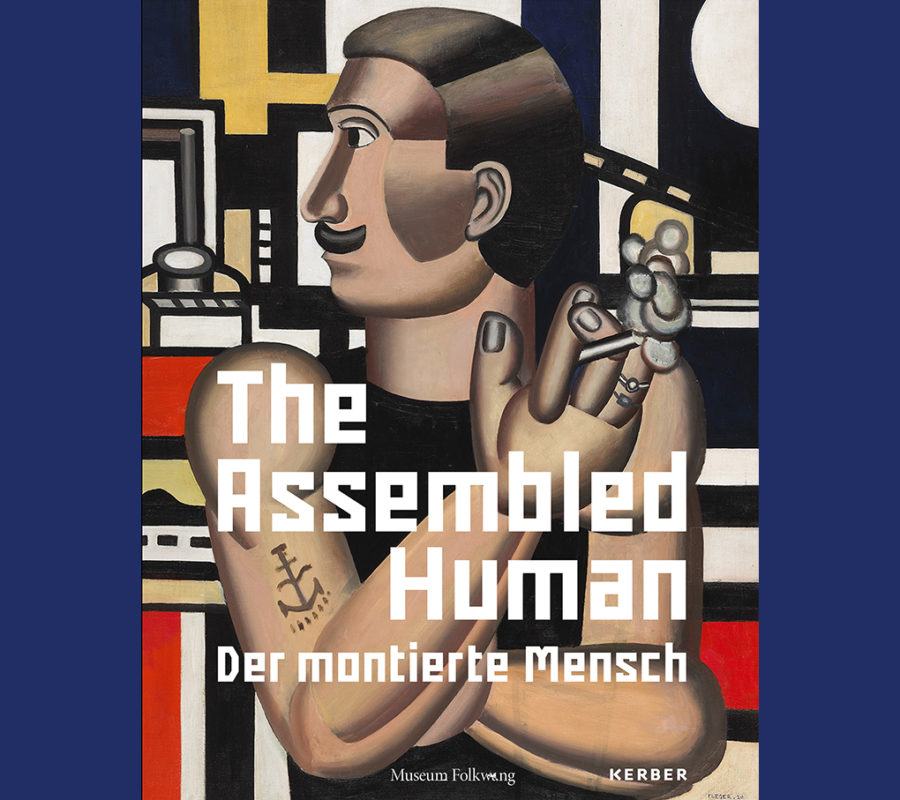
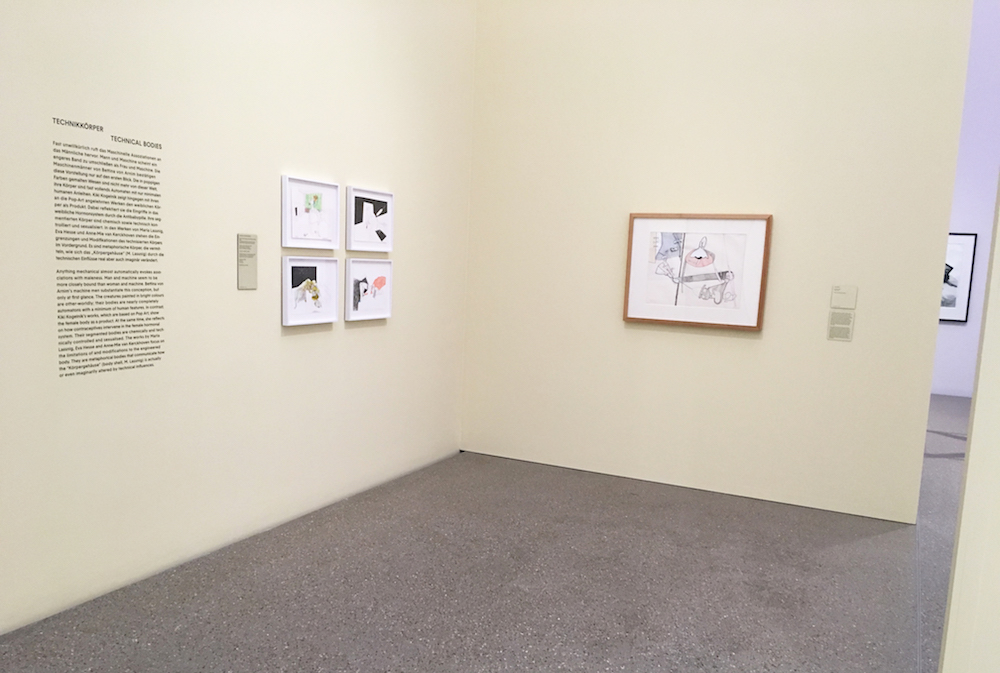
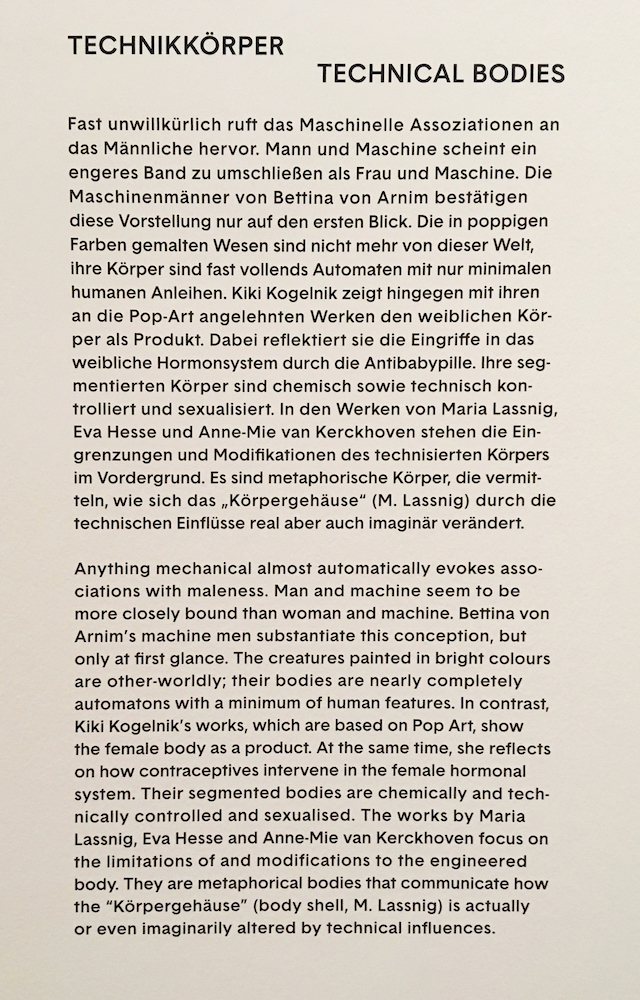
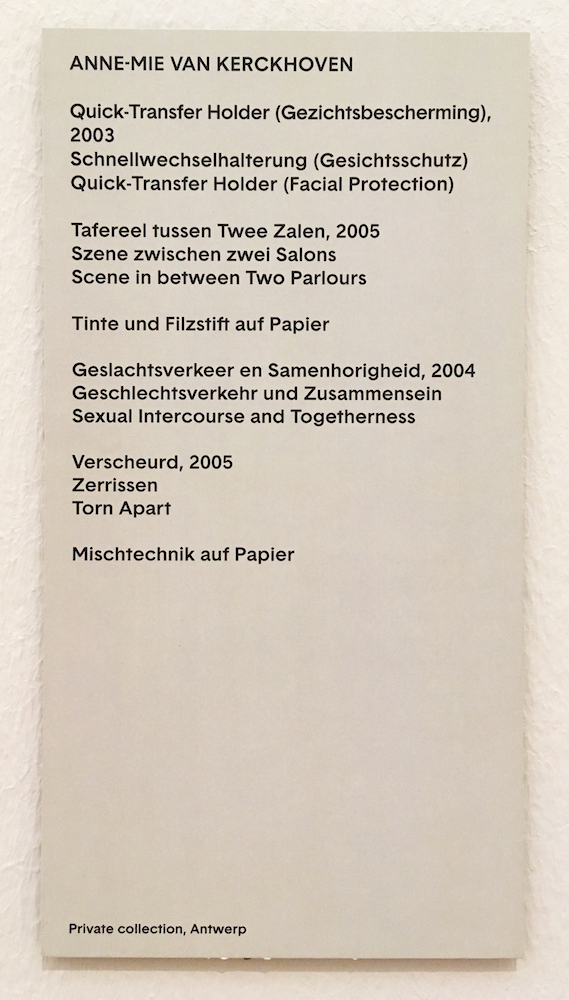
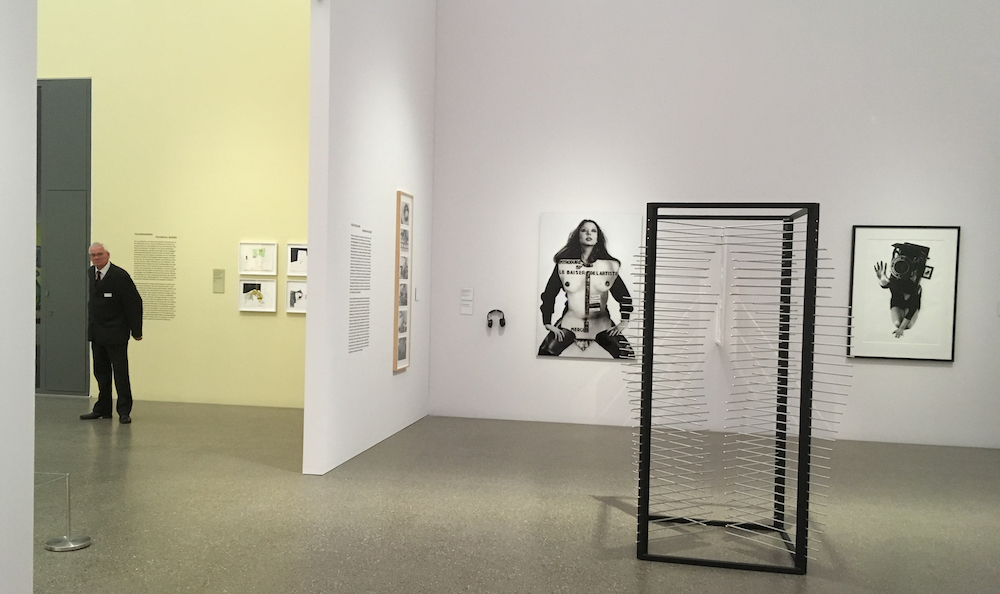
Museum Folkwang presents a show that transcends media and epochs to explore the major societal issues and upheavals of the last 150 years. The Assembled Human presents art as a mirror of industrialisation, technologisation and digitisation. It provides a cultural-historical survey that encompasses key works of painting and graphic design, early experiments in photography, installations and films, along with recent works of Post-Internet Art.
The exhibition focuses on the manifold entanglements between human beings and machines, which are explored in several thematic sections. From the Industrial Revolution to the Information Age, generations of artists have dealt with technological innovations and their impact on humankind. The international loans shown in the exhibition range from photographic records of early industrialisation to Modernist art. They cover experiments in video and performance art from the 1960s through to contemporary art – because today more than ever, technological progress is inextricably linked with anxieties over losses of freedom and individuality. Contemporary works reflect current artistic investigations into the new possibilities and impossibilities that the digital age entails.
The large-scale exhibition presents the interaction between humans and machines in the 20th century. Against the background of digital and technological innovations, it unfolds a panorama of artistic imagery that presents humans as hybrid creatures; they merge with the machines and technologies they create. In the 20th century, crucial changes manifest themselves in the shift of this interrelationship.
The fundamental ambivalence—the relationship between humans and their machines has always alternated between a promise for the future and fears—also characterizes the present day. As a backdrop for contemplating current technological innovations such as industry 4.0, digital surveillance, and the economic upheavals in recent decades, the exhibition provides a historical overview of the developments since the turn of the 20th century with a look to the present. It is imagery that would not have been possible without industrialization and later cybernetic thought, which led to the digital.
The point of departure of the exhibition is the Museum Folkwang’s collection. Numerous loans, including from abroad, will complete the picture. In five chapters and on 1,500 square meters of exhibition space, the presentation tells a story of the Western world and makes reference to global connecting factors.
I. The Machine of the Future
When, beginning in 1872, Eadweard Muybridge disassembles the human being into individual images by means of his so-called chronophotographs, the machine—in this case the camera— merges with the human. From Marcel Duchamp to Fortunato Depero, artists produce images of men who can no longer be separated from their mechanized surroundings, with far-reaching consequences for Cubism and Futurism. They are often positive about technological progress and occasionally associate it with utopian hopes for a better world. Futurists such as Umberto Boccioni proclaim that man will develop into a machine, and the machine into a man (1912). In the First Manifesto of Futurism, Filippo Tommaso Marinetti longs for the immortal “mechanized human” (1909). The arts are to be brought into line with the logic of the machine.
II. Actuating the Lever
During World War I, the critical perception of the world of machines continues, above all on the part of the Dada movement; doubts about progress grow. After the end of the war, numerous artists turn towards realistic manners of representation; the machine as a fear-evoking reality returns New Objectivity. Mistrust and criticism of social conditions mix with the euphoria; artists time and again critically reflect on the working conditions in factories. Hybrid creatures between man and machine appear in Dada and Surrealism, from Giorgio de Chirico to Hannah Höch. Whether connoted positively or negatively, the world of machines becomes the defining subject of artistic production. If one follows the art historian Franz Roh, then “in its powerful mechanics, the machine even becomes a symbol and a model” (1925); talk is of a proper “machine romanticism.” The ability of humans to control machines becomes questionable; the body itself begins to turn into a kind of machine. The world of machines sets people’s pace: productivity instead of contemplation. They sleep in shifts, because machines do not require sleep but have to be kept running. In the early 1920s, Gerd Arntz invents the pictogram, creating an alternative form of sociopolitical communication. Hence, individual bodies can be depicted as part of society, demonstrating proportions and power relations. At the same time, the individual body seems exchangeable, increasingly disappears into the crowd. With reference to the disciplining of the body in modernity, Michel Foucault speaks of “perfect training” (1975). The Cologne Progressives develop their own concept of the human being in the industrial age; they paint figures in geometric formulas, and individual features are hardly discernible. Meanwhile, in the cinema, Dziga Vertov celebrates the speed and complexity of the industrialized and mechanized world in The Man with the Movie Camera (1929), thus confronting the threatening omnipresence of machines in Fritz Lang’s Metropolis (1927), in which the main character, the inventor and scientist Rotwang, predicts: “Twenty-four more hours, and no one ... will distinguish the machine-person from one born of this Earth!”
III. The State as Megamachine
As Lewis Mumford has demonstrated, the state as “megamachine” plays an outstanding role in the totalitarian systems of the first half of the 20th century. The individual body merges into the body politic, which has to constantly be engendered as an imaginary image. Parades, marches, and propagandistic large-scale events in the Soviet Union, Italy, and National Socialist Germany leave their mark on an entire generation. Bodies are as hard as (Krupp) steel, gears in a larger machine and orchestratedly invincible, become part of the (war) machine. The visual worlds of Alexander Rodchenko or Leni Riefenstahl feature the human being in a collective body—strong, deindividualized, and fit for the future. The human body appears as a fatalistic functional unit. As a perfectly organized “omnipotence,” the military forces its way further and further into people’s mindscapes. From today’s point of view, the totalitarian visual worlds perhaps convey an all- embracing void and human baseness. Strength right up to overcoming death and belief in the impossible can likewise be read in the governmentally staged worlds. At the same time, in Modern Times (1936) Charlie Chaplin presents the flip side of industrialization: mass unemployment, time pressure, and alienated work in Fordism.
IV. The Extended Human
After World War II, intellectuals and artists process the basic principles of cybernetics, which was developed in the military sector and is understood as an interdisciplinary field. Fundamental are thoughts on networking, on the feedback loop, and the resulting flexibility and adaptation. It is about a new society that sees itself as a mechanistic system. The feedback loop guarantees a continuous relationship between human and machine as well as between individual and society. What is essential is the self-regulation of systems, the role of linear thinking and causal logic, as well as the notion that organic and mechanical systems are fundamentally exchangeable. The viewer cannot assume an independent position, because he or she is always already part of the system. This results in a dynamic reaction between the components and therefore also between artistic work and viewers. This is essential for the development of performance art. The exhibition correlates this with references to the London-based Independent Group, the 9 Evenings. Theatre and Engeneering of E.A.T. in New York, video art, and Minimal Art. Andy Warhol famously wanted to become a machine himself; with Man, Machine and Motion (1955–2012), Richard Hamilton develops a pioneering installation that addresses the extension of the powers of the human body by technology. Rebecca Horn, Orlan, or Stelarc extend their own bodies by actual technical constructions. If one follows the cultural philosopher Paul Virilio, Stelarc even makes the ultimate appropriation of the body by industry visible in his works (1994). In these decades, the connection between humans and their machines and technologies become increasingly multifaceted and complex. Its relevance for the individual’s everyday life heightens, in particular in the private sphere: there is hardly a household that does not have a television set or kitchen appliances. In 1977, Helen Chadwick ironically takes up this theme in the series In the Kitchen, recently acquired by the Museum Folkwang, in which she wears, for example, a plastic washing machine as a dress.
V. In the Data Stream
The 1987 German census is carried out on paper, although computerized industries and personal computers, and hence computer games, experience increasing prevalence. In the United States, the first experiments with augmented reality are performed as early as the 1950s. In 1965, for research purposes the scientist Ivan Sutherland makes possible a virtual 3-D world with the aid of special glasses. In artistic production, this technology plays a role for the first time in works by Char Davies. In 1995, with Osmose the artist takes the viewer into an individually controllable virtual world. At this moment, human perception partially merges into the digitally generated world; in this respect, the human being actually merges with the machine.
In the meantime, the digital has utterly penetrated and substantially altered our reality. It has become completely natural to use our technical instruments on a daily basis: the mobile telephone is always close at hand, measures the number of steps we take each day; apps react to our diet and sleeping schedule, we can have chips implanted underneath our skin and use them as front door keys. The technologies are often no longer visible as such but disappear behind smooth surfaces. They simplify everyday life, accelerate our communication, and make an enormous volume of information retrievable via the Internet. The increasing reliance on technology turns a power outage into a worst-case scenario; it would bring a large number of economic and social processes to a standstill.
The power of the digital is founded in the essential shift of thinking and acting into the invisible. This is where the feeling of powerlessness can find its counterpart. This applies to invisible surveillance methods, drone wars via remote control, self-learning programs (deep learning), whose paths of derivation humans can no longer comprehend.
At the same time, the much-discussed question is whether artificial entities can effectuate creative or artistic processes. This boundary is currently dissolving more and more, poses questions concerning digital identity and its blending with real identity. This aspect will be dealt with in the presentation based on selected contemporary works by Sophia al Maria, Hito Steyerl, Ed Atkins, or Ian Cheng and Sidsel Meineche Hansen—with an open end.
Binary thinking has influenced Western concepts since René Descartes’ rationalism; it has meanwhile become internalized. However, if one follows considerations by Alexander Kluge, at the same time this gives rise to the excluded other, the third party. Therein lies the core aspect of The Assembled Human. Because mechanistic thought is not conceivable without a counter- concept; this third party, which according to Kluge is only apparently in danger of being excluded but ultimately cannot be, has a permanent place in art. In this respect, the exhibition pursues the history of artistic imagination as a self-reflexive means, as artists cause humans to merge with their machines; they create images for a perceived and anticipated relation to the technological and at the same time develop a counter-model and demonstrate that this act is a deeply human one and that it cannot make sense to allow it to be performed by machines. In this respect, the exhibition The Assembled Human wants to lead to the essence humankind.
Artists:
Walter Heinz Allner, Bettina von Arnim, Gerd Arntz, Ed Atkins, Giacomo Balla, Joachim Bandau, Lenora de Barros, Willi Baumeister, Thomas Bayrle, Rudolf Belling, Ella Bergmann-Michel, Renato Bertelli, Alexandra Bircken, Umberto Boccioni, Wilhelm Braune, John Cage, Helen Chadwick, Computer Technique Group (CTG), Charles A. Csuri, Mariechen Danz, Fortunato Depero, Walter Dexel, Otto Dix, Marcel Duchamp, Raymond Duchamp-Villon, Charles & Ray Eames, Max Ernst, Alexandra Exter, Öyvind Fahlström, Harun Farocki, William Allan Fetter, Otto Fischer, Herbert W. Franke, Carl Grossberg, George Grosz, Richard Hamilton, Barbara Hammer, Sidsel Meineche Hansen, Raoul Hausmann, John Heartfield, Lynn Hershman Leeson, Eva Hesse, Heinrich Hoerle, Rebecca Horn, Vilmos Huszár, Boris Ignatowitsch, Fritz Kahn, Wassily Kandinsky, Anne-Mie Van Kerckhoven, Friedrich Kiesler, Konrad Klapheck, Jürgen Klauke, Heinrich Kley, Josh Kline, Iwan Kljun, Alexander Kluge, Kiki Kogelnik, Germaine Krull, Boris Kudojarow, Helmuth Kurth, Jürgen van Kranenbrock, Maria Lassnig, Fernand Léger, Alice Lex-Nerlinger, Roy Lichtenstein, El Lissitzky, Hilary Lloyd, Goshka Macuga, René Magritte, Kasimir Malewitsch, Man Ray, Étienne-Jules Marey, Rémy Markowitsch, Caroline Mesquita, László Moholy-Nagy, Johannes Molzahn, Alexei Morgunow, Martin Munkácsi, Eadweard Muybridge, Otto Neurath, Katja Novitskova, ORLAN, Tony Oursler, Trevor Paglen, Nam June Paik, Eduardo Paolozzi, Georgi Petrusow, Antoine Pevsner, Walter Pichler, Jon Rafman, Robert Rauschenberg, Timm Rautert, Alexander Rodtschenko, Thomas Ruff, Walter Ruttmann, James Shaffer, Arkadi Schaichet, Xanti Schawinsky, Helmut Schenk, Oskar Schlemmer, Nicolas Schöffer, Franz Wilhelm Seiwert, Avery Singer, Stelarc, Friedemann von Stockhausen, Thayaht, Paul Thek, Jean Tinguely, Patrick Tresset, Anna Uddenberg, Erwin Wendt, Hugo von Werden, George Widener
Der Montierte Mensch
from 08 Nov 2019 to 15 Mar 2020
in Museum Folkwang, 45128 Essen, Germany.
3887 views